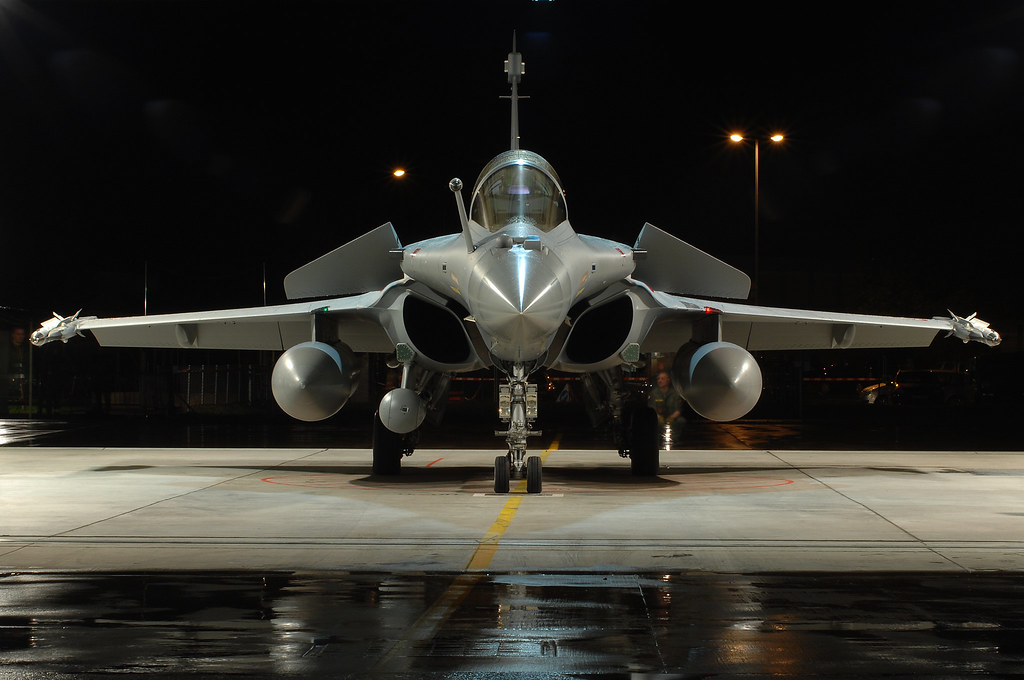The Dassault Rafale is a twin-engine, omnirole, canard delta wing fighter aircraft. Developed indigenously by French Dassault Aviation, the aircraft fully complies with the requirement to carry out the widest range of roles.
Follow us on Google News to get the latest defense news and analysis
According to Dassault Aviation, the aircraft participates in permanent “Quick Reaction Alert” (QRA) for deep strike missions, air-defense and air sovereignty missions, power protection and deployments for external missions, reconnaissance missions, and nuclear deterrence duties.
Dassault Rafale Development History:
In the mid 1970s, the French Air Force and Navy presented the joint requirement for the future omni-role fighter aircraft to replace their current fleets of fighter jets.
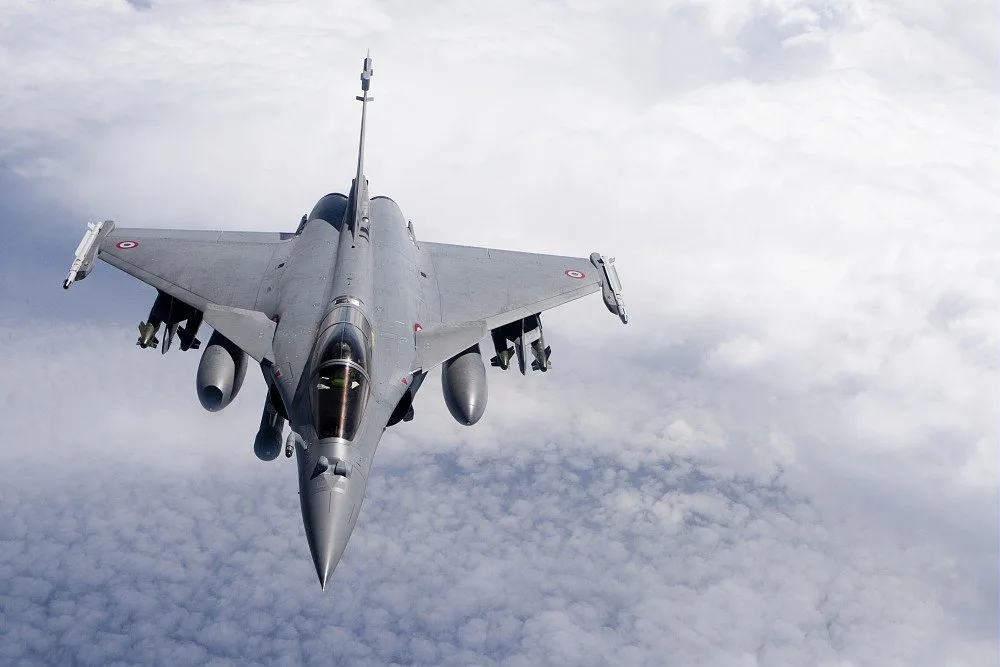
In 1975, the French Ministry of Aviation initiated studies for future aircraft that would replace the older aircraft fleets and fulfill the future needs of the air force and navy.
The future aircraft would have to replace the seven types of combat aircraft then in operation. And also carry out the widest range of missions including;
- Air-Defence / Air Superiority Missions
- Anti-Access / Area Denial
- Close Air Support
- Dynamic Targeting
- Reconnaissance
- Air-to-surface Precision Strike
- Anti-Ship Attacks
- Nuclear Deterrence
- Buddy-Buddy Refueling
The French government with other European nations including UK, Germany, Italy, and Spain also agreed to develop a “Future European Fighter Aircraft” (FEFA) or “European Combat Aircraft” (ECA) in the beginning to fulfill its air force needs regarding future threats and a cost-effective solution to modernize its air force. But a number of factors and air force requirements led to the eventual split between France and other European countries.
The Rafale project was launched in the mid 1970s.
Design and Production of Rafale Fighter Jet:
The Dassault Rafale aircraft was completely designed within France using ‘Computer Aided Three-Dimensional Interactive Application’ (CATIA) and a 3D computer aided design (CAD). Dassault used state-of-the-art techniques never before tested on an aircraft manufacture program.
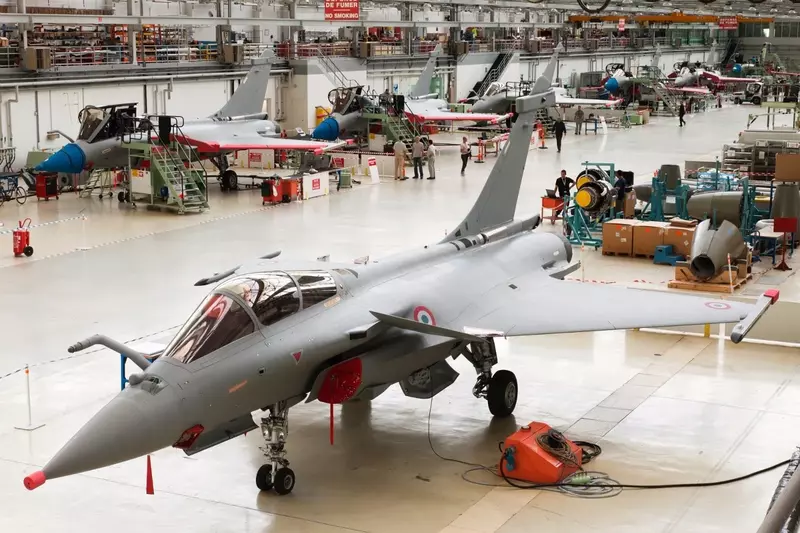
From the earlier beginning of the development phase, the French MoD assigned very stringent “integrated logistic support” (ILS) requirements to the Rafale programme. Using computer aided design (CAD), a CATIA software suite and bold technological choices with the combination of 20+ years of experience in combat-proven Mirage 2000 jets, helps Dassault Aviation to produce the state-of-the-art Rafale fighter jet.
This French fighter jet has close-coupled canards in front with delta wing structure. Front canards provide some level of stability to the aerodynamically unstable jet and also helps it in extreme maneuvers. The close coupling between the canards and delta wings ensures the wide range of center of gravity positions for all flight conditions as well as excellent handling throughout the whole flight path.
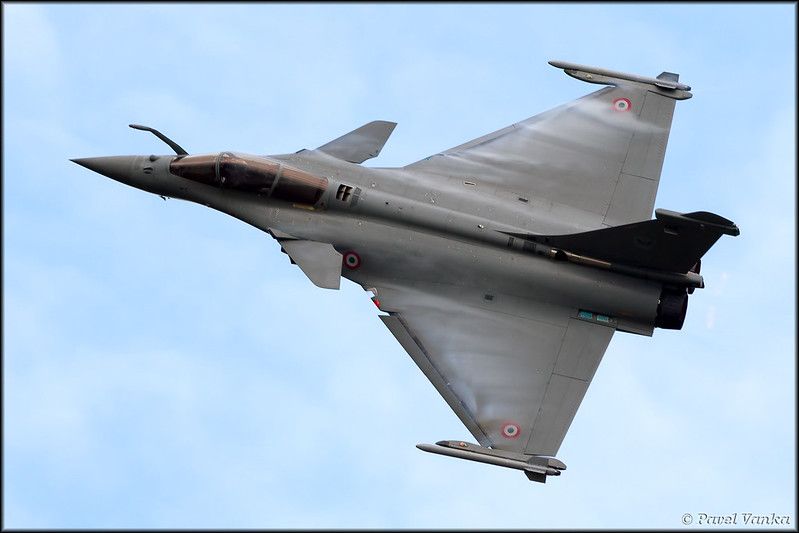
The Rafale jet uses the digital Fly-by-Wire (FBW) Flight Control System (FCS) which artificially enforce and maintain stability during flight. The digital FBW Flight Control System also provides superior performance handling. The FCS is quadruple redundant with three digital channels and one separately designed analogue channel with no mechanical back-up. The FCS is designed independence between channels is key to avoid simultaneous anomalies on all channels.
The one significant feature of the flight control system of the aircraft offers auto flight in terrain following mode in all weather conditions, allowing the fighter jet to fly unobserved in the opponent’s airspace. This feature greatly enhances the aircraft survivability in a high threat environment.
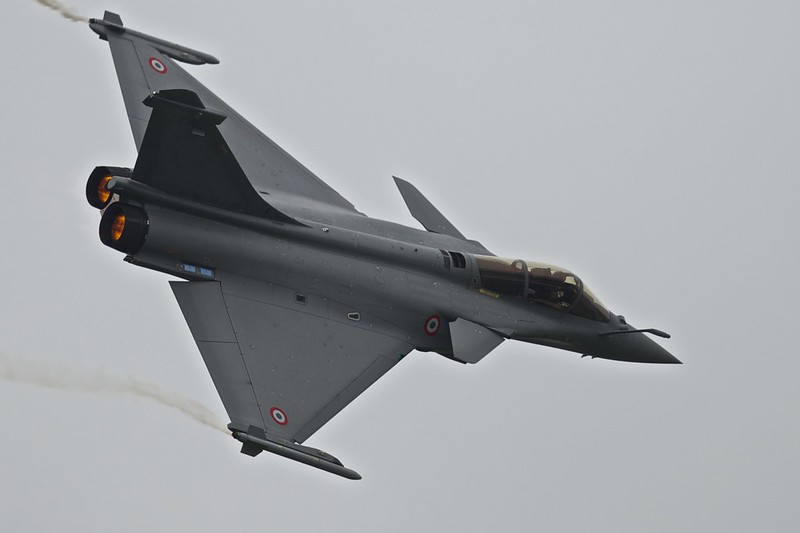
The airframe of the Dassault Rafale jet has been designed in a way that can sustain over 30 years of operation without heavy structural upgrades. The composite materials are extensively used in the airframe, and they account for 70% of the wetted area. The Dassault Aviation has been recognized for designing such sturdy airframes and their know-how in finite element modeling. The airframe fatigue is monitored with the same gauge-free concept which has proved its worth on the Mirage 2000 fleet.
The French Rafale is fitted with an on-board oxygen generation system (OBOGS). So, there is no need for liquid oxygen refilling. The cooling system for optronics is provided by a closed-loop nitrogen circuit, which negates a need for a dedicated nitrogen supply.
US Army, Argonne scientists discover nanoparticles for future weapon systems
The aircraft entered service with the French Navy in 2004 and the French Air Force in 2006. According to Airforce-Technology.
The first squadron of Dassault Rafale B and C was established for the French Air Force in 2006. While the second squadron was set up in 2008. A $3.89 billion contract was awarded to Dassault Aviation, Thales, Snecma, and other French defense firms by the Ministry of Defense in 2004 to develop the fully capable F3 standard fighter aircraft. The first F3 standard aircraft was delivered to the French Air Force in 2008.
According to French armed forces the Rafale deal included four batches of Rafale fighter jets to date. These orders comprise 13, 48, 59, and 60 aircraft respectively. Out of 180 fighter jets, 132 Rafale Bs (two-seater) and Cs (single-seater) delivered to the French Air and Space Force, while 48 Rafale M (single-seater) have been delivered to the French Navy. In January 2021, an additional batch of 12 Rafales was ordered by France to replace 12 aircraft sold to Greece.
While 325 Rafale aircraft had been ordered (133 for export) and 239 delivered at the end of 2021. By 2022, there are 453 French Rafale jets on order out of which 261 are for export deals, once the UAE, Indonesia, and Greece contracts come into effect.
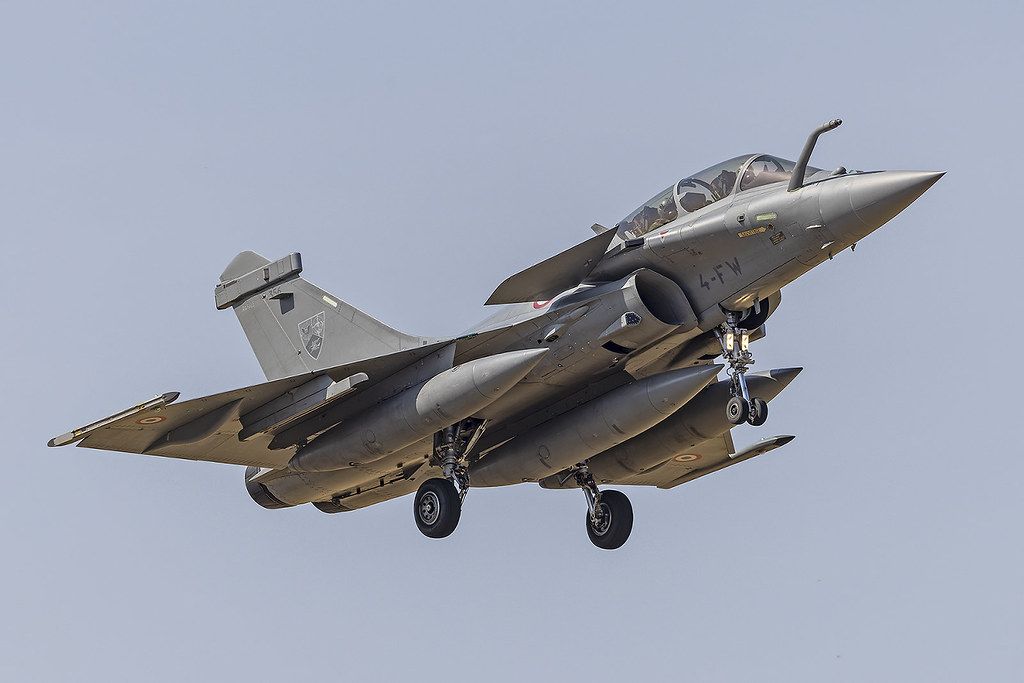
Rafale Fighter Jet Price:
It costs around €100 million for a single Rafale jet. And it takes one month to manufacture this aircraft. France-24 reported.
The French Defense procurement agency (DGA) presented the Dassault Rafale F3-R standard in October 2018. The F3-R is the advanced variant of the F3 standard with improved versatility. In early 2017, the French government also approved the development of the latest and most advanced Rafale F4 standard.
The new F4 standard in French Rafale aircraft includes radar and Front Sector Optronics (FSO) upgrades, helmet-mounted sight capability, Mica-NG air-to-air missiles, and 1000 kg AASM/HAMMER air-to-ground weapons. Also, the new F4 standard provides new connectivity solutions in net-centric combat and paves the way for the Future Combat Air System (FCAS). The timeline for this new aircraft is 2024.
Avionics and Sensor Suit:
According to Dassault Aviation, the aircraft’s ‘multi-sensor data fusion’ process runs on data provided by all sensors of the aircraft. It allows the pilot to act as a true “tactical decision maker”, rather than being only a sensor operator.
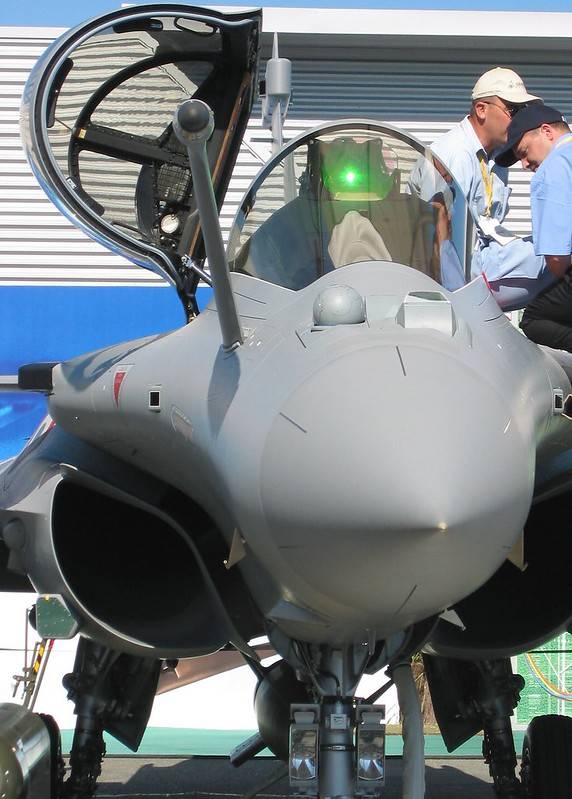
Cockpit:
Dassault Aviation has developed a very easy to use Man-Machine Interface (MMI), combining the ‘Hands on Throttle and Stick’ (HOTAS) control concepts with touch screens.
It features a highly integrated suite of equipment with unique ‘Head-up Display’ (HUD) providing a wide field of view. It also has a multi-image color ‘Head-Level Display’ (HLD) and two left and right color touch screens.
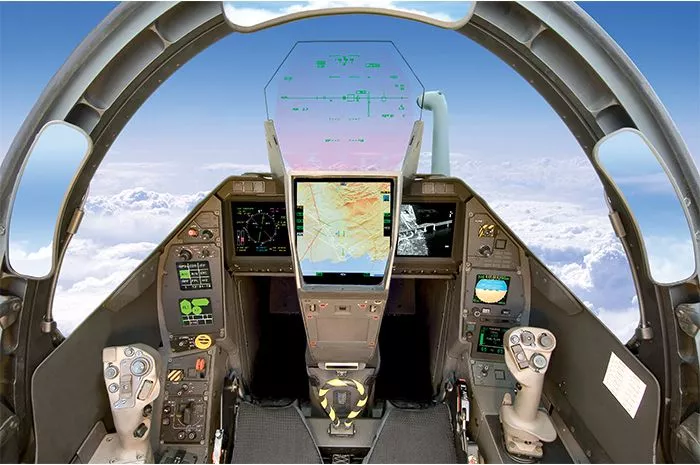
“The comprehensive design of the cockpit provides for everything that aircrew can expect from an ‘omni-role’ fighter,” Dassault Aviation reported. “A wide field of view at the front, on both sides, and at rear, a superior agility, an increased ‘G-protection’ with 29 degrees tilted seats and an efficient air conditioning system demonstrated under all climates.”
SPECTRA Internal EW Suite:
The Dassault Rafale fighter jet is integrated with the SPECTRA internal “Electronic Warfare” (EW) suite. Jointly developed by Thales and MBDA, the SPECTRA EW system is the cornerstone of the fighter jet’s outstanding survivability.
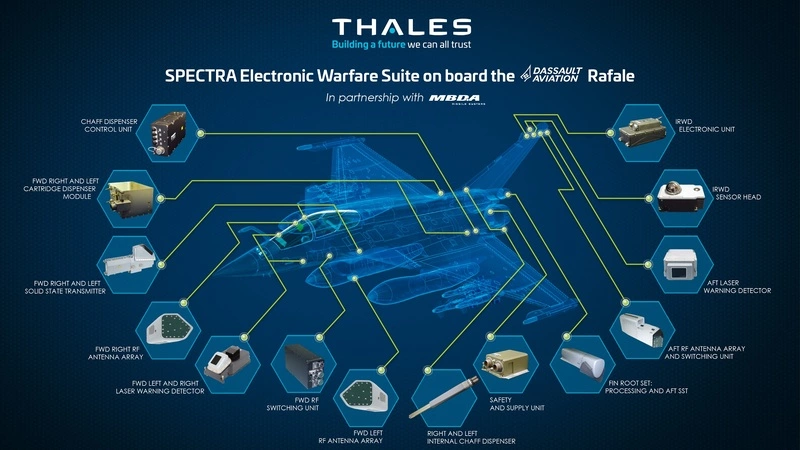
The SPECTRA system carries out reliable long-range detection, identification, and localization of threats, allowing the pilot to instantly select the most effective defensive measures based on combination of radar jamming, infrared or radar decoying and evasive maneuvers. The system uses the solid-state transmitter technology.
The angular localization performance of the SPECTRA sensors makes it possible to accurately locate ground threats in order to avoid them, or to target them for destruction with precision guided munitions.
SPECTRA warfare suite’s threat library can be easily defined, integrated, and updated on short notice by users in their own country, and in full autonomy. This feature is very instrumental in terms of performance.
SPECTRA system also includes a new generation missile approach warning system that offers increased detection performance against the latest threats. The system is fully integrated with other systems in the aircraft, and it provides multi-spectral threat warning capability against hostile radars, missiles, and lasers.
Front Sector Optronics (FSO):
Front Sector Optronics (FSO) system, developed by Thales, is fully integrated into the aircraft. The FSO provides covert long-range detection and identification of enemy aircraft in close combat conditions by operating at optronics wavelength. It is also immune to radar jamming and provides high resolution angular tracking and laser range-finding for air, sea, and ground targets.
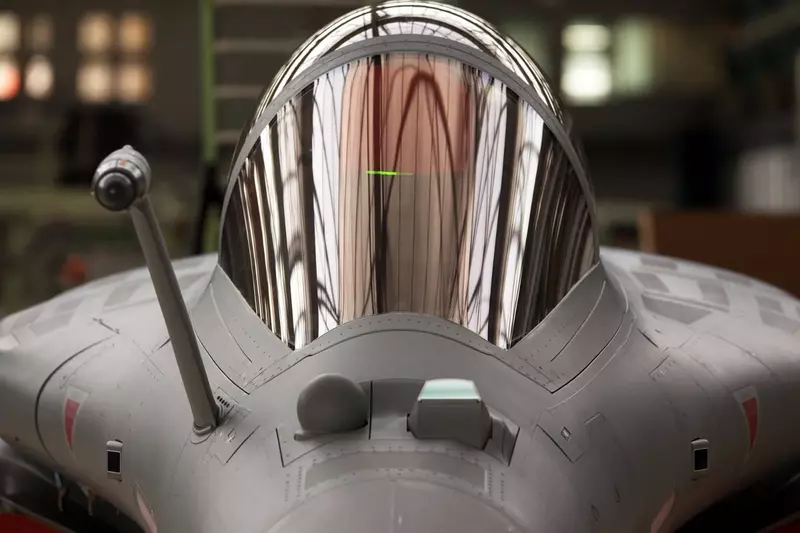
“The FSO’s powerful TV sensor (cued by the Rafale’s active and passive sensors) is truly valuable to positively identify targets in situations where a visual contact is required by rules of engagement.” Dassault Aviation.
Targeting And Laser Designation Pod (TALIOS):
Thales has designed a new Talios targeting and laser designator pod for Rafale aircraft. It provides day and night surveillance and laser designation capability to the aircraft with metric precision. It also permits laser-guided weapons to be delivered at stand-off range and altitude. The pod is interoperable with all existing laser guided weapons.
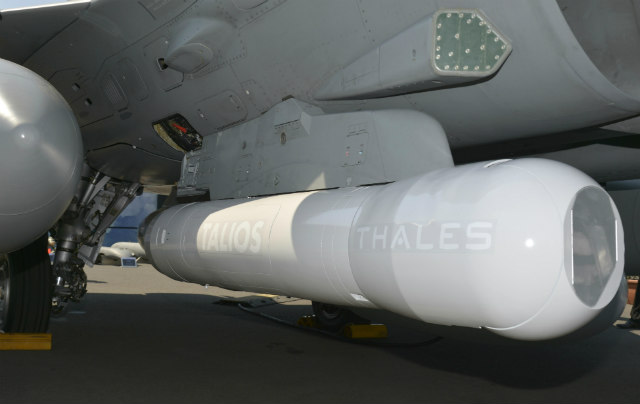
The infrared sensor of the Talios pod operates in the mid-wave infrared and is coupled to a high-resolution new generation TV sensor.
AREOS – RECCE Pod:
Rafale aircraft also integrated with the AREOS reconnaissance system. The AREOS is a new generation pod which helps in strategic and tactical reconnaissance missions. It is a high-tech day and night equipment that can be used in a wide range of scenarios, at stand-off distances from high to low altitudes. It is fitted with a data link which allows high resolution images to be transmitted back to military decision makers in real time. This allows to shorten the intelligence gathering cycle and accelerate the tempo of operations.
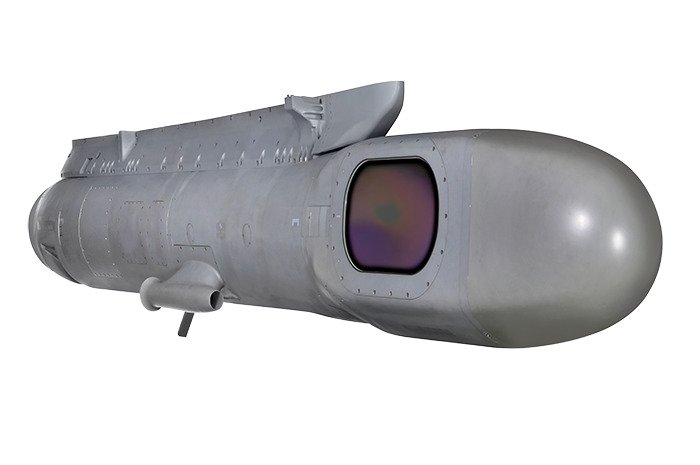
The outstanding performance of AREOS reconnaissance pod during Libya, Mali, Iraq, Syria, and Central African Republic operations make it a sensor with true strategic value.
Dassault Rafale comes up with a secure high-rate data link provided to share data in combined air operations in real time with other aircraft in the formation, airborne and surface command and control centers, tactical air controllers or other friendly assets. According to Dassault, the Link 16 data link is also available to those customers that are cleared to operate it.
As a network centric asset, Rafale fighter jet can exchange images and videos of the target with the forward air controller on ground. This helps to prevent blue-on-blue incidents and collateral damage during peacekeeping missions.
Multi-sensor Data Fusion Concept:
The multi-sensor data fusion concept implemented on Rafale fighter jet allows the pilot to act as a true ‘tactical decision maker’ rather than being only a sensor operator.
According to Dassault Aviation, the core of these enhanced capabilities of the Rafale fighter jet lies in a “Modular Data Processing Unit” (MDPU) incorporating ‘commercial off the shelf’ (COTS) elements. It is composed of up to 19 flight ‘line-replaceable units’ (LRUs) with 18 of them individually providing 50 times the processing power of a typical mission computer employed in previous generation fighters.
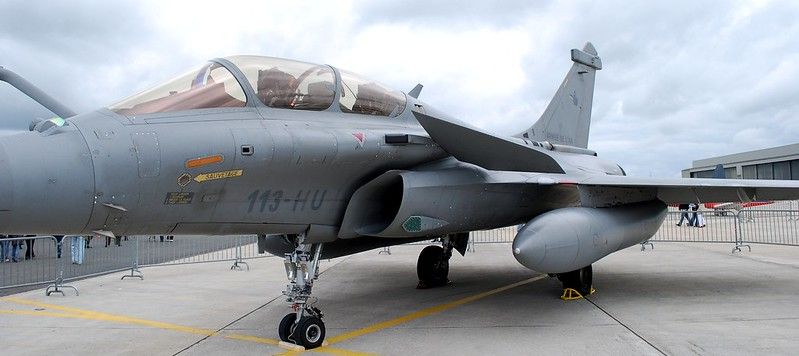
The MDPU is the cornerstone of the upgradeability of the Rafale aircraft. It features a seamless integration of new weapons and capabilities to maintain the war fighting relevance over the years to come.
The ‘multi-sensor data fusion’ provides a link between the battlespace surrounding the aircraft and the pilot’s brain with its unique ability to grasp the outcome of tactical situations and make sensible decisions.
“It hinges on the computing power of the MDPU to process data from the RBE2 AESA radar, the ‘Front Sector Optronics’ (FSO) system, the SPECTRA EW system, the IFF, the MICA infrared seeker, and the data link.” Dassault Aviation.
The ‘multi-sensor data fusion’ technology helps pilot to reduce workload, increase situational awareness, and quick response in battle environments.
Rafale Electrical Systems:
Thales developed an advanced electrical system for Rafale which includes a variable frequency power generation system as compared to traditional constant frequency technology. This approach is used to reduce the weight of the aircraft and helps minimize maintenance cost. This system captured the mechanical power of the aircraft engine and converted it to electricity to supply to different on-board systems.
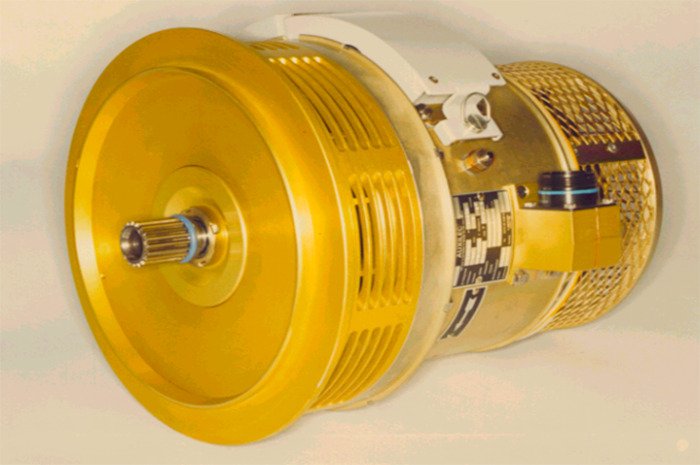
Rafale Radar:
The French Rafale comes up with the RBE2 active electronically scanned array (AESA) radar.
The radar provides an unprecedented level of situational awareness as compared to conventional antennas with earlier detection and tracking of multiple targets.
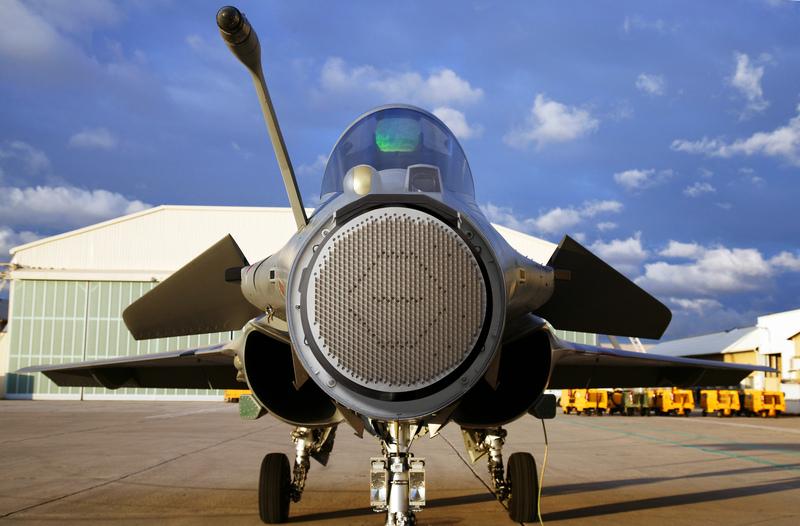
Developed by Thales, the RBE2 AESA radar has benefited from a massive research effort and unmatched know-how based on past experience. Thales calls it a very high-performance radar designed specifically for Rafale omnirole fighter. The RBE2 was Europe’s first AESA radar delivered to forces.
“With its superior beam agility and its enormous computing power, the RBE2 offers outstanding performance that cannot be replicated by mechanical scanning radars.” According to Dassault Aviation.
The first AESA equipped Rafale fighter jet was delivered to the French MoD in 2012.
The RBE2 radar provides a wide range of functions including:
- All-aspect look-up and look-down detection and tracking of multiple air targets for close combat and long-range interception in all weather and in severe jamming environments
- Ability to track targets in or out of the search domain, bringing the ultimate advantage in air combat
- Realtime generation of 3D maps for terrain-following above uncharted terrain in blind conditions. The Rafale is the sole new generation combat aircraft to currently purpose such a function
- Realtime generation of high resolution 2D ground maps for navigation updates and detection, identification, and designation of ground targets
- Greater waveform agility for SAR (Synthetic Aperture Radar) imaging and improved resistance to jamming
The radar can track up to eight targets simultaneously and provides threat identification and prioritization. According to Airforce-Technology.
Also the radar cross section has been kept to the lowest possible value by selecting the most adequate outer mold line and materials. Most of the stealth design features are classified, but some of them are clearly visible such as the serrated patterns on the trailing edge of the wings and canards.
Dassault Aviation reported that the RBE2 radar is fully compatible in terms of detection range with the upcoming long-range METEOR air-to-air missile. AESA radars offer an unprecedented growth-potential for the future.
Rafale Engine:
Dassault Rafale is powered by two M88-2 new-generation turbofan engines. It offers a high thrust-to-weight ratio.
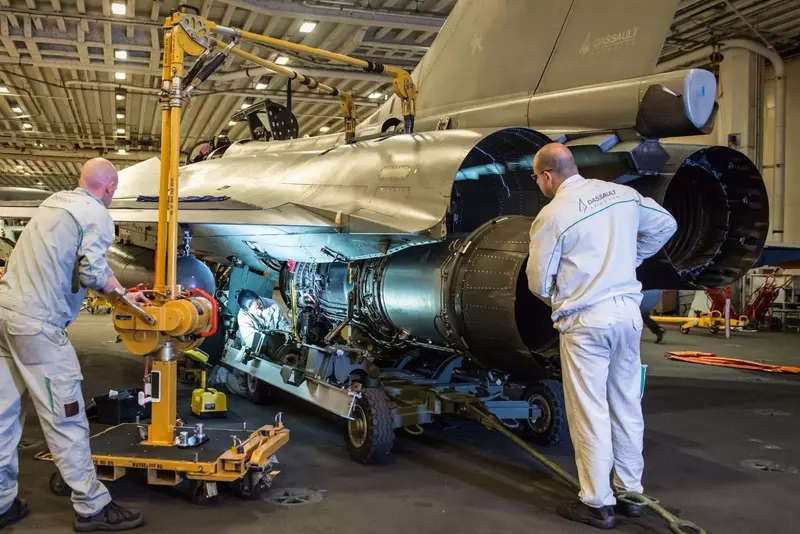
According to Dassault Aviation, this new-generation twin engine is easy to maintain, has high dispatch reliability and lower operating costs.
The M88-2 engine provides 10,971 lbs dry thrust while 16,620 lbs with afterburner. Combined power supply of two engines for each aircraft is 2 x 75kN. Using this power, the Rafale fighter jet can achieve a maximum speed of 1.8 mach.
The power plant is equipped with redundant “Full Authority Digital Engine Control” (FADEC). This provides carefree engine handling anywhere during flight: the throttle can be slammed from combat power to idle and back to combat power again, with less than three seconds from idle to full afterburner. Dassault Aviation reported.
The engine incorporates advanced technologies such as integrally bladed compressor disks, a low-pollution combustor with smoke-free emissions, single-crystal high-pressure turbine blades, ceramic coatings, and composite materials.
According to Dassault Aviation official website, the M88 engine TCO (Total Cost Ownership) program was launched in 2008 to improve engine durability and bring support cost down. Capitalizing on the ECO project, Safran Aircraft Engines (A French aerospace and military engine manufacturer) was able to upgrade the high-pressure compressor and high-pressure turbine of the M88-2: cooling is ameliorated and stronger components have been introduced. This boosts the durability of up to 50%. This enhances the life expectancy between overhaul for a number of aircraft models.
Safran Aircraft Engines have upgraded the M88 engine to the latest M88-4E version. The latest engine model is now fully operational. Production deliveries began in 2012.
Performance:
According to Dassault Aviation, the Rafale has exhibited a remarkable survivability rate during the latest French Air Force and Navy operations, thanks to an optimized airframe and to a wide range of smart and discrete sensors.
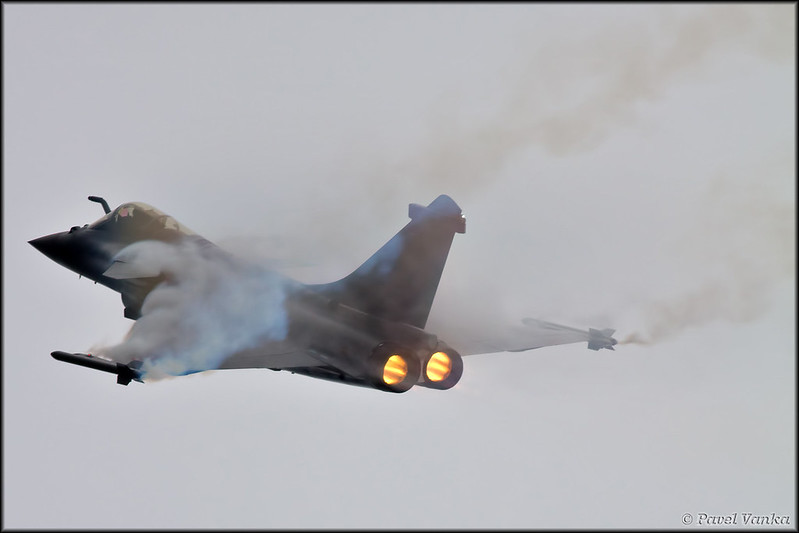
Rafale fighter aircraft have a maximum speed of Mach 1.8. It can push to the limits of – 3.2g to +9g. It has a service ceiling of 50,000 ft. According to the official report from Dassault Aviation.
It has a wingspan of 10.90 m, length of 15.30 m, and height of 5.30 m. The overall empty weight is 10 tons (22000 lbs) and max take-off weight is 24.5 tons (54000 lbs).
The jet has an internal fuel capacity of 4.7 tons (10,300 lbs). It can carry up to 6.7 tons (14,700 lbs) of external fuel tanks.
Rafale has maximum thrust of 2 x 7.5 tons. The aircraft can move with the max speed of mach 1.8 (750 knots). Approach speed is less than 120 knots. Landing ground run without drag-chute is 450 m. Official stats presented on Dassault Aviation website.
The compact design of the aircraft, the delta wing with close coupled canards makes the aircraft fully agile during high angle-of-attack and provides an unmatched range performance in strike missions with heavy weapon loads.
The Fly-by-Wire Flight Control System of the jet developed by Dassault Aviation attains the highest level of flight safety by having over one million flight hours without a single accident.
The network centric capability of the Rafale fighter aircraft hinges on its open architecture, its data fusion software and its compatibility with a variety of data links which plug the jet into the integrated battlespace.
Due to extensive use of the composite materials in the airframe, the aircraft’s max take-off weight to empty weight ratio increased by 40% compared with traditional airframes built of aluminum and titanium.
Since 2013, all Rafales have been delivered with AESA radar, new missile launch detector (DDM-NG) and updated Front Sector Optronics (FSO-IT), offering improved target detection and identification.
“The Rafale is safe and easy to fly in all flight regimes, featuring the same precise, yet benign handling performance in all load-out configurations throughout the flight envelope.” Dassault Aviation.
Rafale Weapon Package:
The Rafale has 14 hardpoints under its wings and fuselage. Five of them are capable of carrying heavy ordnance and drop tanks. The total external load capacity is more than nine tons equivalent to its own empty weight.
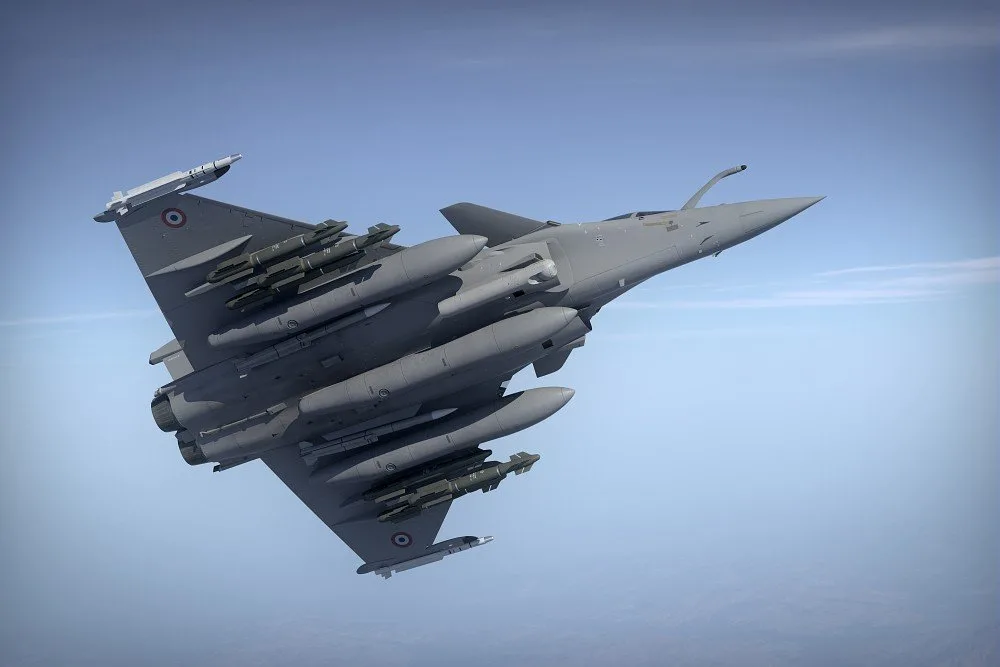
Air-to-air:
Air-to-air weapons include:
- MICA air-to-air missile. It has two variants, MICA EM (active radar homing) medium-range or ‘beyond visual range’ (BVR) missile and MICA IR (heat-seeking) short-range or ‘within visual range’ (WVR) missile.
- METEOR very long-range air-to-air missile. It also has an advanced METEOR EM variant with active radar homing. The integration of METEOR EM with Rafale is a real paradigm change in air-to-air combat.
Air-to-Ground:
Air-to-ground weapons include:
- HAMMER (Highly Agile and Maneuverable Munition Extended Range) air-to-ground missile. It is a rocket-boosted, modular air-to-ground precision guided weapon series, fitted with INS/GPS or INS/GPS/IIR (imaging-infrared) guidance kits or with the upcoming INS/GPS/laser guidance.
- SCALP (European Storm Shadow) long-range, stand-off missile. It is a low-observable, long-range, air-launched cruise missile. Now produced by French MBDA, a conventionally armed, deep strike weapon, designed to attack pre-planned attacks against stationary targets. It Has a range of 250+ km, a weight of 1300 kg and length of 5.10m.
- Laser guided bombs with different warheads from 500 lbs to 2000 lbs.
- Non-guided classic bombs
Air-to-surface:
Air-to-surface or anti-ship missiles include:
- AM39 EXOCET anti-ship missile. Can be launched from strike aircraft, maritime patrol aircraft and helicopters. It has a range of up to 70 km.
According to Dassault, the mission system of the aircraft has the potential to integrate a variety of current and future armaments.
The Rafale’s stores management system is Mil-Std-1760 compliant, which provides easy integration of customer selected weapons.
The aircraft is also fitted with ‘NEXTER 30M791’ 30 mm internal cannon. It has the capacity of firing 2500 rounds/min.
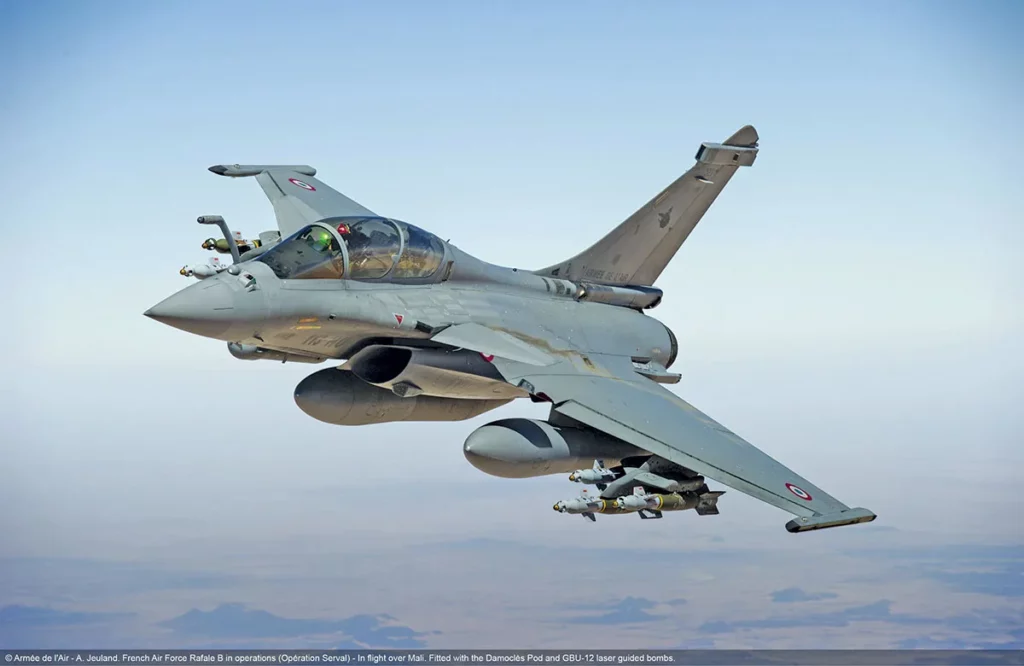
“With its outstanding load-carrying capability and its advanced mission system, the Rafale can carry out both air-to-ground strikes, as well as air-to-air attacks and interceptions during the same sortie.” Dassault Aviation.
Rafale Variants:
The Dassault Rafale has now been evolved to C (F3 or F3-R) standard or third evolution and the new F4 standard is underway.
Now the French Air Force is currently using single-seat Rafale C, two-seat Rafale B, and the French Navy is using the single-seat Rafale M.
Rafale B (Two-seater variant, Air Force)
Rafale C (Single-seater variant, Air Force)
Rafale M (Single-seater variant, Navy)
Operational History:
The Rafale aircraft was first deployed in Afghanistan from 2007 to 2011. Both the French Air Force and Navy took part during the operations. French forces successfully employed HAMMER precision guided air-to-ground weapons, laser-guided bombs, and 30mm cannon against the ground targets.
The French Air Force and Navy also took part in coalition operations over Libya. French forces carried out large portion of the spectrum of missions with Rafale jets including air Superiority, precision strikes with HAMMERS, deep strikes with SCALP cruise missiles, intelligence, surveillance, Tactical Acquisition and Reconnaissance (ISTAR), and Strike Coordination and Reconnaissance (SCAR). During the operations, Rafale hit hundreds of targets with high accuracy including tanks, artillery, fuel and ammunition storage dumps, command centers and air defense systems.
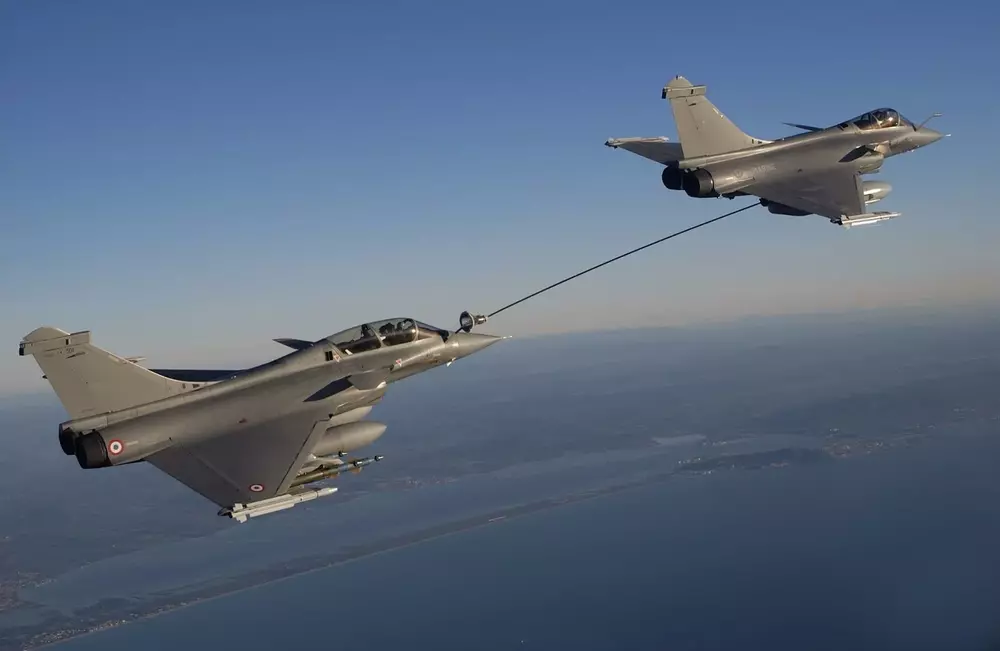
From 2013 to 2015, French forces were involved in operations in Mali. During the operation, 4 Rafale fighter jets undertook the longest raid in French Air Force history, taking-off from Saint-Dizier in Eastern France and landed in N’Djamena, the capital of Chad. During this raid, Rafale engaged 21 targets and spent almost 9 hours and 35 minutes airborne.
Dassault Rafale jets are also involved in air strikes in the Middle East, Iraq, and Syria as a part of an international coalition.
Customers:
The French government has ordered 42 more Rafale fighter jets worth $5.5 billion.
Qatar signed a contract with Dassault Aviation to acquire 24 French fighter jets in 2015. The $7 billion Rafale deal also includes an option for 12 additional fighters. The deliveries started in February 2019. Airforce-Technology reported.
The Indian government also finalized a contract worth around $8 billion for the acquisition of 36 Rafale fighter aircraft. According to ‘GlobalSecurity.org’ report, India had selected the Rafale as the winner of its MMRCA (Medium Weight Multi-Role Combat Aircraft) competition .
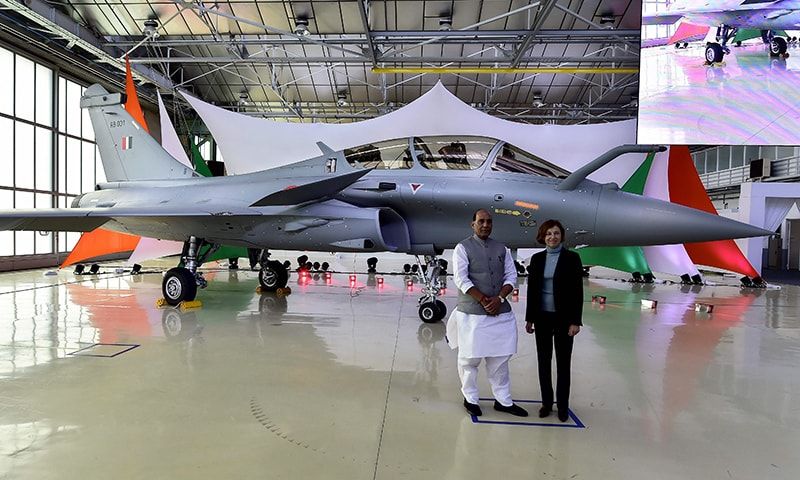
Dassault Aviation also signed a contract with Egypt in 2015 to supply 24 Rafale fighter jets. Egypt has increased its order to 54 jets, including 24 in 2015. Also Egypt is the first export customer of the Rafale aircraft.
Greece also ordered 18 aircraft which includes 6 new and 12 second-hand jets. Deal was finalized in January 2021. According to Thales Group’s official website.
Croatia has ordered for 12 second-hand Rafales in November 2021. And received its first two jets in October 2023.
The United Arab Emirates made a contract for 80 Rafale jets in December 2021. According to Dassault CEO, Eric Trappier, the deal is the “most important contract ever obtained by the French military aeronautics”. The contract worth €16 billion (including €2 billion for weapons) is a record for a French aircraft manufacturer. The UAE is the sixth customer of the Rafale aircraft in the international market.
According to Thales, Indonesia also placed an order for 42 Rafale latest-generation aircraft in February 2022.
Analysis:
“It is capable of performing several actions at the same time, such as firing air-to-air missiles during a very low altitude penetration phase,” Dassault Aviation. “A clear demonstration of the true ‘omnirole’ capability and outstanding survivability of the rafale.”
In-short the aircraft fully complies with the requirement to carry out the widest range of roles with the smallest number of aircraft.
Dassault Aviation described the aircraft as versatile and best in all categories of missions and called it a true force multiplier.
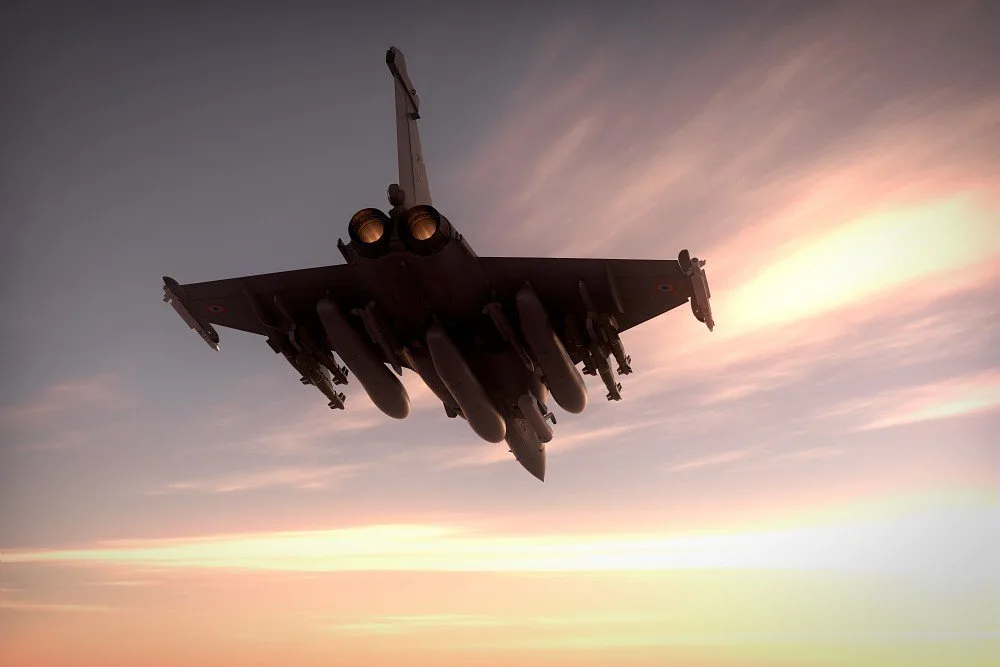
“Of a moderate size, yet extremely powerful, superbly agile and very discrete, the latest type of combat aircraft from Dassault Aviation does not only integrate the largest and most modern range of sensors, it also multiplies their efficiency with a technological breakthrough, the ‘multi-sensor data fusion’.” Dassault Aviation.
The fighter jet was developed as a modern aircraft that can be comparable to the next generation fighter jets in terms of avionics and sensor suits.
The aircraft is expected to be the French armed forces’ prime combat aircraft until 2050.
Quick Info About the French Dassault Rafale:
Which countries have Rafale?
Currently France, Qatar, India, Egypt, Greece, and Croatia are using this aircraft. While orders from UAE, Saudi Arabia, Indonesia are in the pipeline.
What is the price of the Rafale?
It costs around €100 million for a single Rafale jet. And it takes one month to manufacture this aircraft. France-24 reported.
How many Dassault Rafale India has?
Total 36 Rafale aircraft have been delivered to India so far while around 26 more jets will be ordered for the Indian Navy.
What is the top speed of a Rafale jet?
Dassault Rafale has a maximum speed of mach 1.8.
Which country has the most Rafales?
France operates more Rafale jets than any other nation.
How many Rafale does Qatar have?
Qatar is operating 24 Rafale jets while 36 more are on order.
Is the Rafale better than the Eurofighter?
Both these jets have their own usage according to the needs of the air forces around the globe. But in some ways Eurofighter Typhoon is better in terms of radar and weapons package than Rafale.
Why is India not buying more Rafale?
India is currently operating 36 Rafale fighter aircraft and may place more orders for its Navy.
How many Rafale France have?
France is currently operating 180 Rafale fighter jets while already placed an order of 42 more jets in January 2024.
What are the specifications of the Rafale aircraft?
The Rafale aircraft have following specifications; 4.5 generation, multi-role, 1.8 mach top speed and a bunch of other features.


